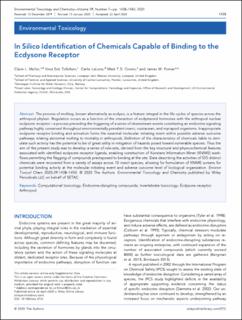| dc.contributor.author | Mellor, Claire L. | |
| dc.contributor.author | Tollefsen, Knut-Erik | |
| dc.contributor.author | LaLone, Carlie | |
| dc.contributor.author | Cronin, Mark T.D. | |
| dc.contributor.author | Firman, James W. | |
| dc.date.accessioned | 2020-09-17T11:32:52Z | |
| dc.date.available | 2020-09-17T11:32:52Z | |
| dc.date.created | 2020-09-04T10:10:19Z | |
| dc.date.issued | 2020 | |
| dc.identifier.citation | Environmental Toxicology and Chemistry. 2020, 39 (7), 1438-1450. | en_US |
| dc.identifier.issn | 0730-7268 | |
| dc.identifier.uri | https://hdl.handle.net/11250/2678262 | |
| dc.description.abstract | The process of molting, known alternatively as ecdysis, is a feature integral in the life cycles of species across the arthropod phylum. Regulation occurs as a function of the interaction of ecdysteroid hormones with the arthropod nuclear ecdysone receptor—a process preceding the triggering of a series of downstream events constituting an endocrine signaling pathway highly conserved throughout environmentally prevalent insect, crustacean, and myriapod organisms. Inappropriate ecdysone receptor binding and activation forms the essential molecular initiating event within possible adverse outcome pathways relating abnormal molting to mortality in arthropods. Definition of the characteristics of chemicals liable to stimulate such activity has the potential to be of great utility in mitigation of hazards posed toward vulnerable species. Thus the aim of the present study was to develop a series of rule‐sets, derived from the key structural and physicochemical features associated with identified ecdysone receptor ligands, enabling construction of Konstanz Information Miner (KNIME) workflows permitting the flagging of compounds predisposed to binding at the site. Data describing the activities of 555 distinct chemicals were recovered from a variety of assays across 10 insect species, allowing for formulation of KNIME screens for potential binding activity at the molecular initiating event and adverse outcome level of biological organization. Environ Toxicol Chem 2020;39:1438–1450. © 2020 The Authors. Environmental Toxicology and Chemistry published by Wiley Periodicals LLC on behalf of SETAC. | en_US |
| dc.language.iso | eng | en_US |
| dc.publisher | Wiley | en_US |
| dc.rights | Navngivelse 4.0 Internasjonal | * |
| dc.rights.uri | http://creativecommons.org/licenses/by/4.0/deed.no | * |
| dc.title | In silico identification of chemicals capable of binding to the ecdysone receptor | en_US |
| dc.type | Peer reviewed | en_US |
| dc.type | Journal article | en_US |
| dc.description.version | publishedVersion | en_US |
| dc.source.pagenumber | 1438-1450 | en_US |
| dc.source.volume | 39 | en_US |
| dc.source.journal | Environmental Toxicology and Chemistry | en_US |
| dc.source.issue | 7 | en_US |
| dc.identifier.doi | 10.1002/etc.4733 | |
| dc.identifier.cristin | 1827299 | |
| dc.relation.project | Norges forskningsråd: 221455 | en_US |
| cristin.ispublished | true | |
| cristin.fulltext | original | |
| cristin.qualitycode | 2 | |

